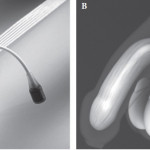Re: Selective arterial clamping does not improve outcomes in RAPN: a propensity-score analysis of patients without impaired renal function
Letter to the Editor
Selective arterial clamping does not improve outcomes in RAPN: a propensity-score analysis of patients without impaired renal function
Sir,
With immense interest we have read the article published in your esteemed journal titled “Selective arterial clamping does not improve outcomes in robot-assisted partial nephrectomy (RAPN): a propensity-score analysis of patients without impaired renal function” by Paulucci et al [1]. The strength of this study is that it is the largest comparison of patients undergoing selective arterial clamping (SAC) vs main arterial clamping (MAC) during RAPN to date. The authors have appropriately analysed the database from four medical centres where RAPN were done. They have taken due care to prevent bias by using propensity score analysis. After going through this article we want to discuss a few observations with the authors of this article.
The authors had mentioned that Simmons et al [2] found that renal ischemia does not have a significant effect on renal function when the warm ischemia time (WIT) < 25 min. This might be due to the kidney’s remarkable ability to recruit additional renal function from its nephrons in response to ischemic injury as shown in studies with 99Tc-MAG3 [3]. So it would be logical to think from the above published data that SAC will not have much advantage in terms of renal function preservation following PN when the WIT is < 25 min. The same outcome was derived from the present study also. It would be interesting to know whether SAC is advantageous over MAC in renal function preservation following PN when the WIT > 25 min. The authors should have analysed the outcomes of such patients with WIT > 25 min undergoing MAC vs SAC during RAPN. If the outcome of such analysis shows that SAC is better than MAC in terms of renal function preservation on early or intermediate follow up, then that would be an important message to the existing literature available on the outcome of PN.
The authors should clarify in the statistical analysis and results section, the data mentioned about the patients with WIT < 25 min (n) is 533 MAC patients in pre-propensity-score-matched subset and 122 MAC patients in post-propensity-score-matched subset. But the same data is mentioned differently in Table 1 (520 MAC patients in pre-propensity-score-matched subset and 123 MAC in post-propensity-score-matched subset).
The operating time in MAC group was significantly more compared to SAC group (178 vs 148 min, p value <0.001) in pre-propensity-score-matched subset of patients. Also to note is that estimated blood loss (ml) is more in MAC than the SAC group (75 vs 62.5 ml, p = 0.470) in pre–propensity score matched subjects as mentioned in Table 2. It is logical to think that SAC group should take more time compared with MAC group because in SAC group of patients you need to spend more time to dissect the branches of main renal artery than in MAC group leading to increase in the total operating time and blood loss. The authors should discuss why the operative time and blood loss was less in SAC group. Shao et al [4] in their study on the outcome of laparoscopic partial nephrectomy with segmental artery clamping showed that blood loss and operating time was significantly more in SAC group compared to MAC group.
Dr. Varinder Singh Attri, M.S
Senior Resident, Department of Urology, Post Graduate Institute of Medical Education and Research, Chandigarh, India
Dr. Sudheer Kumar Devana, M.S, M.Ch
Assistant Professor, Department of Urology, Post Graduate Institute of Medical Education and Research, Chandigarh, India
Dr. Ravimohan S Mavuduru, M.S, M.Ch
Associate Professor, Department of Urology, Post Graduate Institute of Medical Education and Research, Chandigarh, India
Dr. Girdhar S Bora, M.S, M.Ch
Assistant Professor, Department of Urology, Post Graduate Institute of Medical Education and Research, Chandigarh, India
References
1. Paulucci DJ, Rosen DC, Sfakianos JP, Whalen MJ, Abaza R, Eun DD, Krane LS, Hemal AK and Badani KK Selective arterial clamping does not improve outcomes in robot-assisted partial nephrectomy: a propensity-score analysis of patients without impaired renal function. BJU Int 2017; 119: 430–35. doi:10.1111/bju.13614.
2. Simmons MN, Hillyer SP, Lee BH, Fergany AF, Kaouk J, Campbell SC Functional recovery after partial nephrectomy: effects of volume loss and ischemic injury. J Urol 2012; 187: 1667–73.
3. Zargar H, Akca O, Autorino R et al Ipsilateral renal function preservation after robot-assisted partial nephrectomy (RAPN): an objective analysis using mercapto-acetyltriglycine (MAG3) renal scan data and volumetric assessment. BJU Int 2015; 115: 787–95.
4. Shao P, Qin C, Yin C, Meng X, Ju X, Li J et al Laparoscopic partial nephrectomy with segmental renal artery clamping: technique and clinical outcomes. Eur Urol 2011; 59: 849–55.
Reply by the authors
We greatly appreciate the opportunity to respond to Dr.’s Attri, Dvana, Mavuduru, and Bora, who raise several interesting points in regards to our paper. A critical question raised pertains to robotic partial nephrectomies (RPNs) with extended warm ischemia time (WIT), a cohort of patients not well addressed in our study. Our particular patient database, curated from several experienced surgeons, has few patients with extended WIT with which to evaluate these critical questions raised by the letter authors. As surgical techniques have advanced to include not only selective arterial clamping (SAC) but also “zero-ischemia”, or super-selective clamping [1], as well as off-clamp techniques [2], the necessity of each innovation must be placed in its proper context. A driving message of our study was the critical importance of understanding that each patient has unique needs. In the patients in our cohort, with predominantly healthy renal function and two working kidneys, SAC showed no benefit, and we hypothesize that other advanced techniques would similarly show no advantage. Several other subsets of patients may benefit though from these advanced techniques: in particular patients with solitary kidneys and those with complex masses that would require extended WIT [3]; indeed, future studies are needed to confirm this. In general, however, even in the most complex lesions that undergo robotic partial nephrectomy, the incidence of ischemia time > 30 minutes is uncommon.
We additionally thank the authors for giving us the chance to clarify the error in the table – there were, as correctly stated in the text of the manuscript, 533 main arterial clamping (MAC) patients pre-propensity score matching and 122 MAC patients post-propensity score matching.
We believe the final point raised regarding lower operative time (OT) and estimated blood loss (EBL) in the SAC patients is due to the selection bias inherent in our pre-propensity score matched cohort. Specifically, while prior to matching, lower OT and EBL for SAC counter-intuitively sends the message that SAC compared to MAC is a simpler procedure, we strongly believe that this difference in EBL and OT reflects the underlying selection bias to choose simpler masses for SAC, a bias which we intentionally controlled for using propensity score matching. In fact, prior to propensity score matching MAC is clearly seen to be used on larger tumors (median 3.1 vs. 2.5 cm). With the use of propensity score matching, and a robust number of MAC cases with which to perform the subsequent analysis, including many that were equally amenable to either technique, this bias is largely eliminated, with no statistically significant differences (p>0.05) in RENAL score, tumor size, baseline eGFR, patient age, and BMI in post-propensity score matched patients, in turn leading to no difference in operative time (p=0.141) or estimated blood loss (p=0.873). Crucially, it is only from this cohort from which we drew our conclusions.
Sincerely,
Ketan K. Badani and David Paulucci
Icahn School of Medicine at Mount Sinai Hospital, Urology
Daniel Rosen
Harvard Medical School
References
- Gill IS, Patil MB, de Castro Abreu AL, Ng C, Cai J, Berger A, et al. Zero Ischemia Anatomical Partial Nephrectomy: A Novel Approach. J Urol. Elsevier; 2012 Mar [cited 2017 Apr 30];187(3):807–15.
- Kaczmarek BF, Tanagho YS, Hillyer SP, Mullins JK, Diaz M, Trinh Q-D, et al. Off-clamp robot-assisted partial nephrectomy preserves renal function: a multi-institutional propensity score analysis. Eur Urol. 2013 Dec [cited 2015 Jul 28];64(6):988–93.
- Tomaszewski JJ, Smaldone MC, Mehrazin R, Kocher N, Ito T, Abbosh P, et al. Anatomic complexity quantitated by nephrometry score is associated with prolonged warm ischemia time during robotic partial nephrectomy. Urology 2014 Aug [cited 2015 Aug 10];84(2):340–4.



